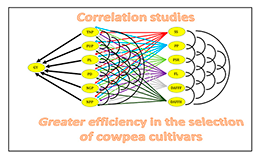Biometric genetics in cowpea beans (Vigna unguiculata (L.) Walp) I: phenotypic and genotypic relations among production components
DOI:
https://doi.org/10.48162/rev.39.102Palabras clave:
análisis de ruta, mejoramiento genético, productividad, relación entre personajes, Vigna unguiculata (L.) Walp, selecciónResumen

In the semi-arid region of Paraíba, cowpea has low productivity due to irregular rainfall and poor use of production technologies. An extensive study aimed at selecting more productive cultivars was conducted using biometric models. This first work had the following objectives: i. Quantify direct and indirect effects of primary and secondary components on grain production; ii. Identify variables with greater potential for cultivar selection in the semiarid region of Paraíba and iii. Determine the most appropriate selection strategies for the evaluated variables. The experiment was conducted in an experimental field. The influence of 6 primary and 6 secondary production components was evaluated on grain yield. Data were subjected to ANOVA. Genetic parameters, correlations and path analysis were estimated. Given the strong direct phenotypic and genotypic effects, pod yield results the most promising variable for higher grain yield selection. Direct and simultaneous selections are the most suitable strategies for the set of evaluated variables. However, further studies on selection indices are necessary to maximize genetic gains.
Highlights
- Variables with greater potential were identified for the selection of superior cultivars of cowpea in the semiarid region of Paraíba.
- The pod yield variable (PP) seems promising for cultivar selection considering higher grain yield (GY).

Descargas
Publicado
Número
Sección
Licencia
Derechos de autor 2023 Revista de la Facultad de Ciencias Agrarias UNCuyo

Esta obra está bajo una licencia internacional Creative Commons Reconocimiento-NoComercial-CompartirIgual 3.0.
Aquellos autores/as que tengan publicaciones con esta revista, aceptan las Políticas Editoriales.


